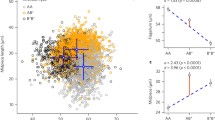Summary
A cross between two strains of mice with different numbers of tailrings which had previously been analyzed as representing mainly a difference in one gene now has been analyzed further with the result that the cross appears to be one between strains differing in at least two genes, one lying in an autosome and the other one in the sex chromosome. Proof for this is the fact that in F1 there is a difference in the number of tailrings between the reciprocal males, but not between the reciprocal females. The same phenomenon is also reported as observed in another cross of two strains not related to the first pair. The preponderance of males in the recessive group of F2 is another indication of the influence of the sex chromosome on the number of tailrings.
Similar content being viewed by others
Literature Cited
Fortuyn, A. B. D., 1931. A cross between mice with different numbers of tailrings. Genetics,16, pp. 591–594.
Fortuyn, A. B. D., 1934. A remarkable cross inMus musculus. Genetica, 16, pp. 321–359.
Painter, T. S., 1928. A comparison of the chromosomes of the rat and mouse etc. Genetics,13, pp. 180–189.
Author information
Authors and Affiliations
Rights and permissions
About this article
Cite this article
Fortuyn, A.B.D. The influence of the sex chromosome on the number of tailrings in mus musculus. Genetica 17, 291–298 (1935). https://doi.org/10.1007/BF01985015
Received:
Issue Date:
DOI: https://doi.org/10.1007/BF01985015




